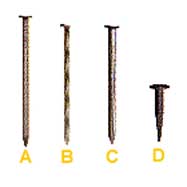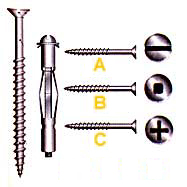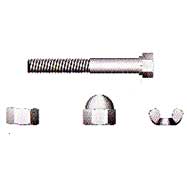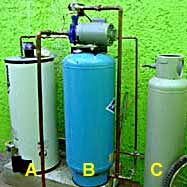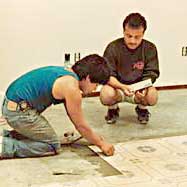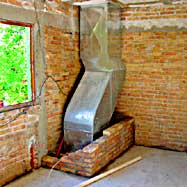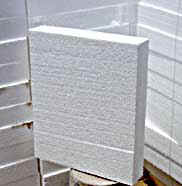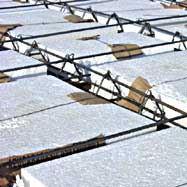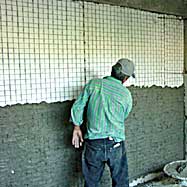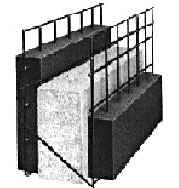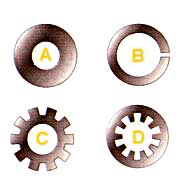| |
|
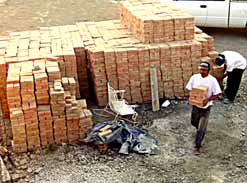
|
The
apprentice workers ayudantes
are carrying bricks ladrillos
to the work area. Concrete blocks are called bloque
de concreto.
Adobe
(right) is little used today.
|
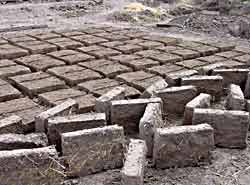
|
 |
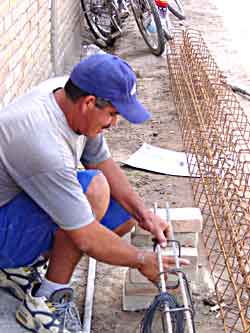
|
A
mason albañil
is usually addressed as maestro.
On the left Maestro
Manolo is assembling the rebar frames esqueletos
(or
castillos) for the concrete columns columnas
(or
castillos)
and beams viguetas
(or
vigas de concreto or
dalas).
He is positioning
metal collars anillos
(or
estribos) around pieces of rebar
varilla
which have been cut to the required length.
Upper
right: He is forming a collar anillo
(or
estribo) from piece of wire rod alambron
using a piece of pipe tubo
and a jig guía
which he has made.
Lower right: He is using a hook tool A. gancho
to twist a piece of wire B. alambre
to hold the collar C. anillo
(or
estribo) in place.
|
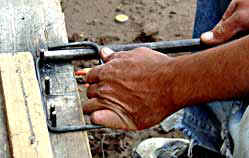 |
|
|
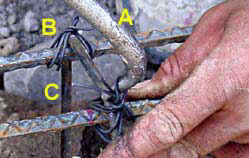 |
|
Rebar varilla
comes in 12 meter lengths in the following diameters:
1/8" = un
octavo
3/8" = tres
octavos
1/2" = media
pulgada
5/8" = cinco
octavos
|
Wire rod alambron
and
binding wire alambre
come in large coils sold by the kilogram.
|
 |
|
Beams
are called by various names in different parts of the country = viguetas,
vigas de concreto, and dalas. They also take on names denoting location or function. |
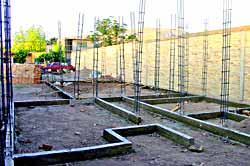 |
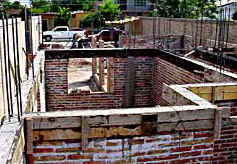 |
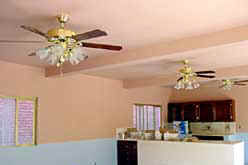 |
|
The
base beam atop the foundation = desplante |
header
beams = cerramiento
|
exposed
beams = vigas |
|
 |
|
Concrete
concreto is a mixture of cement cemento,
lime cal,
sand arena
(sometimes polvo),
gravel grava
and water agua.
The
ratio of the five ingredients varies depending upon the application. |
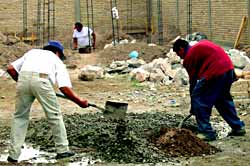 |
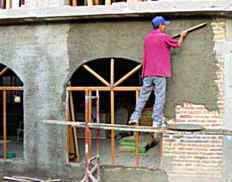
|
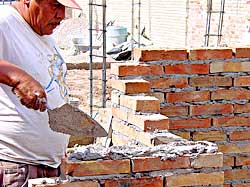 |
|
Concrete
concreto
is usually mixed by hand on the ground or in the street in front of a
project.
A cement mixer revolvedora
de concreto is generally used only for
pouring floors pisos
and roofs tejados. |
Maestro
Iniz stands on scaffolding andamio
as he applies exterior stucco enjarre.
Where stucco is used inside the house, it is usually called by slang
term pasta.
Stucco enjarre
is mixed with little or no gravel grava
and a little more lime cal
and less water agua
than for regular concrete |
The
mortar
mescla
used in laying bricks ladrillos
uses a large amount of lime cal
and no gravel grava.
Mortar
mescla
is often called by the slang term pasta.
|
 |
|
Cal
is known chemically as calcium hydroxide. Other common names are
builders' lime and slaked lime. In addition to its uses in
building, it is used in many industrial processes including the making
of hominy and tortillas. It is made
from calcium oxide which is also sometimes called lime, but more
commonly quicklime. C. hydroxide is a fairly harmless while power
(gloves are recommended, don't breath the dust), while C. oxide is a
fairly dangerous crystalline rock-like material that must be handled
with care (gloves are a must and eye protection). With due care
and certain adjustment to the process, quicklime can be used in place of
builders' lime, but it rarely is. The main exception is in the
making of whitewash blanqueo.
Whitewash blanqueo makes a
good, inexpensive sealer and primer for preparing bricks, concrete and
stucco for painting. Sometimes it is used without a top coat of
paint. When used alone, whitewash has a limited useful life and
must be re-done from time to time. How often depends on the climate
-- the more humid, the shorter its useful life.
Whitewash is made by combining lime, water, salt and a binder. The
binder commonly used in my part of Mexico is cactus paddles nopales.
The lime used can be either builders' lime or quicklime. Quicklime
has the advantage of making the nopales
more efficient. The process begins by course chopping the nopales
and adding them along with salt to a barrel of water. The lime is
then added. (Your maestro will know the correct
proportions.) Quicklime will react with the water releasing heat
and a gas which should not be breathed. The heat will help to
extrude the juice from the cactus. When the water has cooled, it
is ready to be used. When first applied, the whitewash will appear
thin and weak on the wall, but as it absorbs carbon dioxide from the
air, it will turn white and cover the wall. |
 |
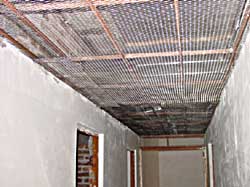 |
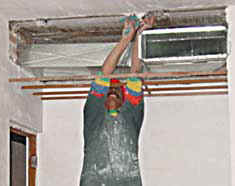
|
 |
The
plaster contractor yesero
is responsible for installing drop ceilings falso
plafón and other enclosures
(also called falsos
plafones) to hide plumbing tubería
or ducts ductos.
These are made with hollow square steel tubing canaleta
which supports a heavy iron mesh tela
to which plaster
yeso is applied. Note that the drop ceiling falso
plafón is attached to the walls
pareds and not hung from above as is commonly done in the
USA. |
|
 |
|
water
tank = tanque
de agua
roof mounted = tinaco
in the ground (cistern) = aljibe
on top of the ground and sometimes in the house =
pila
Both the aljibe and
pila are typically made with
bricks and stucco. Some-times a plastic tank (pictured) is used
in which case it is often called a tinaco
no matter where it is located.
In some areas a water tank is called a cistrerna
no matter where it is located or how it is made. |
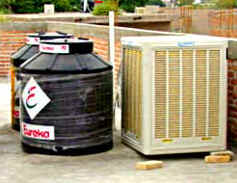
|
air
conditioner = acondicionor de aire
evaporative cooler = aire
lavado
refrigeration
AC =
refrigeración |
|

|
|
|
|
| Electrical,
plumbing and more coming soon. |
Return
to the top |
|
|
|
|
|
|
|
|
|
|
|
|
|
|
|
|
|
|
|
|
|
|
|
|
|
|
|
|
|
|
